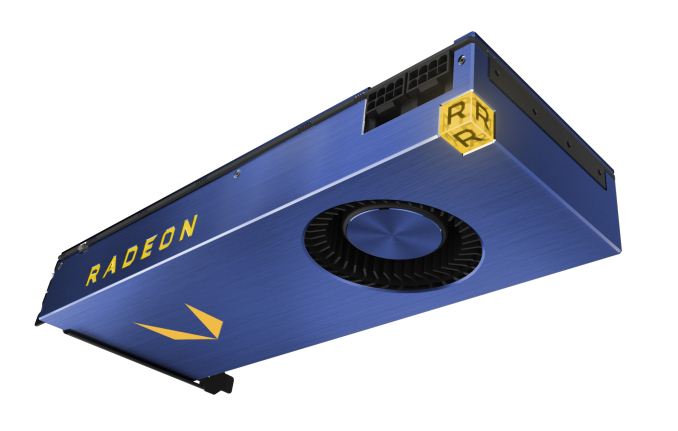AMD Radeon Vega Frontier Edition Retail Listings Appear: Cards at $1199 and $1799
by Ryan Smith on June 16, 2017 10:20 AM EST- Posted in
- GPUs
- AMD
- Radeon
- Vega
- Vega Frontier Edition

Eagerly anticipated for later this month is the launch of AMD’s first wave of Radeon Vega cards, the first-run workstation/early adopter-focused Radeon Vega Frontier Edition. To date, AMD has not yet said anything further about the launch since last month’s Computex unveil, however it appears that either AMD is opting to quietly release the sure to sell out cards, or some of their retailers have jumped the gun, as listings for both models have begun to show up.
SabrePC, one of the industry’s more specialized retailers whom tends to focus on workstation and server products, has posted listings for both of the Radeon Vega Frontier Edition cards that AMD has previously unveiled. That is, both the air-cooled card and the closed loop liquid cooled model. As you’d expect for these early-run cards, they won’t come cheap: the air cooled model is listed at $1199, while the liquid cooled card is higher still at $1799.
As a matter of editorial policy I don’t typically post news about retailer listings; these are often erroneous, or at the very least speculative. However any listings at SabrePC raise an eyebrow as they’re a more straight-laced player and one of the traditional retailers for workstation products. So they’re not known to post faulty listings. Which, coupled with the fact that other workstation retailers are also listing these cards, leads me to believe that this week’s listing isn’t an accident, even if AMD themselves aren't saying more about the product.
In any case, we had no real guidance for where AMD would price these cards at prior to today, so I’m admittedly a bit surprised to see the Frontier Edition cards come in as (relatively) cheap as they have. $1199 for the air cooled card is less than similar NVIDIA Quadros (and Radeon Pro cards, for that matter), and is perfectly aligned with NVIDIA Titan Xp pricing. Meanwhile the liquid cooled card is a bit more surprising with its $600 premium. All messaging so far from AMD is that these are a low volume part meant for customers to evaluate Vega as early as possible, so it’ll be interesting to see where AMD goes from here.
| AMD Workstation Card Specification Comparison | ||||||
| Radeon Vega Frontier Edition (Unconfirmed) |
Radeon Pro Duo (Polaris) | Radeon Pro WX 7100 | Radeon Fury X | |||
| Stream Processors | 4096 | 2 x 2304 | 2304 | 4096 | ||
| Texture Units | ? | 2 x 144 | 144 | 256 | ||
| ROPs | 64? | 2 x 32 | 32 | 64 | ||
| Boost Clock | 1.6GHz | 1243MHz | 1243MHz | 1050MHz | ||
| Single Precision | 13.1 TFLOPS | 11.5 TFLOPS | 5.7 TFLOPS | 8.6 TFLOPS | ||
| Half Precision | 26.2 TFLOPS | 11.5 TFLOPS | 5.7 TFLOPS | 8.6 TFLOPS | ||
| Memory Clock | 1.89Gbps HBM2 | 7Gbps GDDR5 | 7Gbps GDDR5 | 1Gbps HBM | ||
| Memory Bus Width | 2048-bit | 2 x 256-bit | 256-bit | 4096-bit | ||
| Memory Bandwidth | 483GB/sec | 2x 224GB/sec | 224GB/sec | 512GB/sec | ||
| VRAM | 16GB | 2 x 16GB | 8GB | 4GB | ||
| Typical Board Power | ? | 250W | 130W | 275W | ||
| GPU | Vega (1) | Polaris 10 | Polaris 10 | Fiji | ||
| Architecture | Vega | Polaris | Polaris | GCN 1.2 | ||
| Manufacturing Process | GloFo 14nm | GloFo 14nm | GloFo 14nm | TSMC 28nm | ||
| Launch Date | 06/2017 | 05/2017 | 10/2016 | 06/24/15 | ||
| Launch Price | Air: $1199 Liquid: $1799 |
$999 | $649 | $649 | ||
Meanwhile SabrePC also lists technical specifications for the Frontier Edition cards, with both cards listed at the same memory bandwidth and peak throughput. At 13.1 TFLOPS FP32, this would put the GPU clockspeed at 1.6GHz on the dot, just a smidge higher than AMD’s own presentations last month. Meanwhile 483GB/sec of memory bandwidth puts the memory clock at just under 1.9Gbps. That both cards are listed with the same specifications is a bit surprising, and given the price difference I’m not wholly convinced that Sabre has the right specifications for the cheaper air cooled card – distinctly cheaper cards are usually built around harvested processors – but for now it’s what we have to work with. It may very well be that the listings are correct, but the air cooled card is expected to throttle more often relative to the high-efficiency air cooler.
In the meantime I’ve reached out to AMD for more information on these new listings, particularly since AMD's official Frontier Edition release isn't slated to be until the 27th. However quiet nature of these listings does have me wondering if AMD is purposely looking to avoid additional press at the moment – opting to silently get them into the hands of distributors to get out to their professional customers – as the company had made it clear that they’re not aiming these cards at consumers.











61 Comments
View All Comments
Morawka - Friday, June 16, 2017 - link
wrong arch, my bad, i don't believe the whitepapers are out yetRyan Smith - Friday, June 16, 2017 - link
We don't have any new information on that front, but AMD has already been rather up-front on half precision. They can run 2 FP16 ops in place of an FP32 op.http://www.anandtech.com/show/11002/the-amd-vega-g...
gunmaker - Saturday, June 17, 2017 - link
ive been screaming to get a hold of that hbm memeory, say what you want about sse4.1a and avx2, im gauranteeing that hbm will be 3 times faster than sse5 so those specs on the card are completely irrelevant. i can have 2000 high speed missiles on an OLDER graphics card and still hug 70.2 to 80.5 fps. amds nextcore is going to stomp the competition. permanently. maybe its about time they went closed source and started making microsoft and nvidia PAY for thier illigitimate cousin cards.Yojimbo - Friday, June 16, 2017 - link
What do you mean by sorting it out? Did they previously support half precision?tuxfool - Friday, June 16, 2017 - link
Yes. Polaris supports half precision, though not at double rate.Yojimbo - Friday, June 16, 2017 - link
Thanks. So you mean that memory bandwidth usage is halved but compute throughput is the same compared with fp32?tuxfool - Friday, June 16, 2017 - link
Yes. Also IIRC registers are able to store two values fp16 valuesleelab - Friday, June 16, 2017 - link
They are going for the professional data scientists and most likely crypto currency folks. AMD chips are preferred there versus NVIDIA. They routinely sell for over asking price. AMD releasing these chips before the consumer ones may be strategy on their part to sell these for a higher average selling price.Alexvrb - Saturday, June 17, 2017 - link
Crypto currency crunching typically uses consumer GPUs. I imagine for the currencies where GPUs are still vital, that likely still holds true. More bang for the buck.gunmaker - Saturday, June 17, 2017 - link
for bitcoin mining its still more cost effective to purchase 3 amd saphire fury r390 and then use an amd based motherboard. after that you would want to multiplex using a usb c+firewire port to link the mother boards.